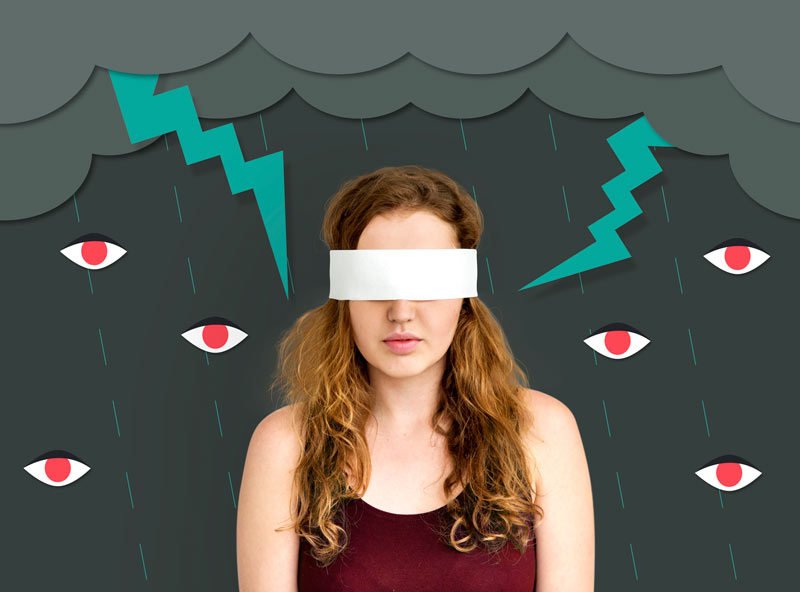Understanding Bipolar Disorder: Can Someone Realize They Are Bipolar?
Understanding Bipolar Disorder: Can Someone Realize They Are Bipolar?

In the realm of mental health, few conditions are as enigmatic and impactful as bipolar disorder. Recognizing the intricacies of this disorder is not only crucial for those who may be directly affected but also for society as a whole. In this blog, we embark on a journey to unravel the mysteries surrounding bipolar disorder. We invite you to accompany us on this enlightening quest as we address a fundamental question: Can individuals genuinely discern if they are grappling with bipolar disorder?
Join us as we navigate this multifaceted topic and uncover the vital insights that can lead to better awareness and management.
Introduction: Exploring Bipolar Disorder
Bipolar disorder, often referred to as manic-depressive illness, is a complex mental health condition characterized by extreme shifts in mood, energy, and behavior. It stands as a significant challenge not only for those directly affected but also for their families, friends, and society at large. This condition can manifest in distinct phases: the manic phase, marked by heightened energy, euphoria, and impulsivity, and the depressive phase, characterized by profound sadness, low energy, and a sense of hopelessness. These fluctuations can be disruptive and have a profound impact on an individual’s daily life, relationships, and overall well-being.
Amidst the multifaceted nature of bipolar disorder, a critical question emerges: Can someone genuinely recognize the signs and symptoms of bipolar disorder within themselves? Exploring this question is essential as it paves the way for early intervention and appropriate management. In this article, we will navigate through the nuances of bipolar disorder, exploring its various facets and providing insights into the self-awareness aspect, aiming to shed light on whether individuals can, indeed, discern if they are grappling with this challenging condition.
Recognizing Bipolar Disorder Symptoms
Recognizing bipolar disorder hinges on understanding its hallmark symptoms and the distinct phases that individuals with the condition may experience. Common symptoms of bipolar disorder encompass a wide spectrum of emotional and behavioral changes. During the manic phase, individuals often exhibit increased energy, reduced need for sleep, grandiosity, racing thoughts, and impulsivity. They might engage in risky behaviors, such as excessive spending or reckless driving. On the flip side, the depressive phase brings forth symptoms like persistent sadness, loss of interest in previously enjoyed activities, changes in appetite and sleep patterns, feelings of worthlessness, and even thoughts of suicide.
These symptoms do not always occur in isolation, and their severity can vary from person to person. Recognizing bipolar disorder entails identifying patterns of mood swings, the frequency and duration of these episodes, and their impact on daily functioning. By comprehending the distinct indicators associated with mania and depression, individuals and their loved ones can begin to discern the presence of bipolar disorder and seek appropriate evaluation and treatment, a crucial step in managing this condition effectively.
Self-Awareness and Bipolar Disorder
Self-awareness plays a pivotal role in recognizing bipolar disorder, but it’s a nuanced process. Many individuals with bipolar disorder may not immediately grasp the full extent of their symptoms, especially during manic phases when they might feel exceptionally confident or during depressive phases when self-esteem can plummet. However, over time, some individuals may begin to notice recurring patterns in their mood and behavior. They might realize that their emotional fluctuations are more extreme and frequent than those of their peers. It’s not uncommon for loved ones or close friends to provide valuable insights as well, pointing out changes in behavior or mood that the affected person may not have noticed themselves.
For example, someone might retrospectively recall periods of excessive energy and impulsivity during manic episodes, followed by prolonged periods of deep sadness and disinterest in activities they once enjoyed during depressive episodes. These realizations, along with the recognition of the detrimental impact of these mood swings on various aspects of their life, can prompt individuals to seek professional evaluation. Self-awareness, when combined with support from mental health professionals and loved ones, is a crucial first step in effectively managing bipolar disorder and improving overall quality of life.
Seeking Professional Help: Diagnosis and Treatment
Recognizing the signs of bipolar disorder is an essential initial step, but the journey toward effective management often requires professional guidance. Seeking help from mental health professionals, such as psychiatrists or clinical psychologists, is of paramount importance to obtain a precise diagnosis. Bipolar disorder can sometimes be misdiagnosed as other conditions, making it imperative to consult an expert who can conduct a thorough evaluation, including a detailed psychiatric history, mood assessments, and in some cases, laboratory tests. An accurate diagnosis is the foundation upon which an individual can build an effective treatment plan tailored to their specific needs.
Once diagnosed, individuals with bipolar disorder have access to a range of treatment options, including medication, psychotherapy, and lifestyle modifications. Medications, such as mood stabilizers and antipsychotics, can help manage the extreme mood swings associated with bipolar disorder. Psychotherapy, including cognitive-behavioral therapy (CBT) and interpersonal therapy, can provide individuals with essential coping skills and strategies to manage their condition effectively.
Additionally, adopting a stable daily routine, engaging in regular exercise, and maintaining a supportive social network can all contribute to symptom management and overall well-being. By emphasizing the importance of professional help and highlighting the diverse treatment approaches available, individuals can take positive steps toward effectively managing bipolar disorder and leading fulfilling lives.
Unveiling Uncommon Types of OCD: Beyond the Ordinary
Unveiling Uncommon Types of OCD: Beyond the Ordinary

Imagine a world where the mind weaves intricate patterns, sometimes steering us into unexpected territories. In this blog, we will get deeper into the lesser-known dimensions of OCD – those that often whisper while the more familiar traits shout. While you’re likely acquainted with the typical portrayals involving cleanliness rituals and repetitive behaviors, there exists an entire spectrum of uncommon OCD types that are equally fascinating. Join us as we peel back the layers, venturing into the extraordinary intricacies that lie beneath the surface. Together, we’ll delve into the heart of “Unveiling Uncommon Types of OCD: Beyond the Ordinary,” where the rich tapestry of human emotions meets the complexities of a condition that never ceases to amaze.
The Intrusive Taboo Thoughts (Taboo OCD)
Within the diverse tapestry of Obsessive-Compulsive Disorder (OCD), a particular thread weaves a unique pattern – the enigmatic presence of intrusive taboo thoughts. This lesser-explored facet of OCD introduces us to a complex world where the mind, often against one’s own wishes, conjures up thoughts that dance on the edges of societal taboos. These thoughts might encompass topics ranging from violence and aggression to taboo desires or forbidden impulses.
At the heart of this experience lies a profound paradox. Individuals grappling with intrusive taboo thoughts are often among the last to endorse or act on such thoughts in real life. However, the mere existence of these thoughts can become a source of distress and confusion. The clash between these intrusive mental fragments and one’s personal values creates a battleground for intense emotions, including guilt, shame, and fear. This inner struggle frequently leads to compulsive behaviors and mental rituals in an attempt to neutralize the discomfort these thoughts evoke. By delving into the world of intrusive taboo thoughts, we gain insights into the complexities of OCD that extend beyond the conventional perceptions of the disorder.
Perfect Symmetry Obsessions and Compulsions
Individuals navigating this form of OCD find themselves entangled in an unrelenting pursuit of equilibrium, where asymmetry becomes an adversary to be conquered. The desire for symmetry goes beyond mere aesthetics; it becomes an all-consuming compulsion that can dictate the rhythm of daily life.
For those with perfect symmetry obsession, the world is a canvas to be meticulously arranged. A misplaced object or an uneven step can trigger an unsettling dissonance, often sparking a cascade of anxious thoughts. The intricate rituals that follow, while aimed at achieving alignment, can paradoxically lead to further distress. From rearranging personal belongings to adjusting body postures, the compulsions are as varied as they are relentless. The impact is not only confined to time and energy but also to the emotional toll of feeling trapped in a constant struggle for balance.
Just-Right OCD: The Quest for Utmost Precision
The hallmark of “just-right” OCD lies in the persistent feeling that something is amiss unless a specific order is attained. This compulsion to ensure things are precisely in their rightful place can lead to a cycle of repetitive actions that disrupt daily routines. From adjusting the angle of a picture frame to aligning objects with imaginary lines, these rituals stem from an intense need for internal equilibrium. However, this quest for perfection often brings anything but contentment. The frustration and distress that accompany the relentless pursuit of the “just-right” sensation can profoundly impact an individual’s emotional well-being and quality of life. By delving into the world of “just-right” OCD, we uncover the intricate mechanisms that drive individuals to seek harmony, even in the smallest details, in a world that rarely adheres to such rigid definitions.
Existential OCD: Navigating the Philosophical Intricacies
Within the intricate tapestry of Obsessive-Compulsive Disorder (OCD), an often-overlooked thread weaves a profound narrative – the realm of existential OCD. Imagine a mind grappling not only with the ordinary challenges of daily life but also with philosophical quandaries that probe the very essence of existence. Individuals ensnared in this unique form of OCD are burdened by obsessions centered around questions of purpose, identity, and the ultimate meaning of life itself.
Existential OCD is a symphony of anxiety-driven ruminations that delve into the philosophical unknown. Thoughts may revolve around morality, the afterlife, or the nature of reality, and these individuals are tormented by the fear that failing to find definitive answers will have dire consequences. This leads to compulsive behaviors, ranging from constant researching to elaborate rituals aimed at appeasing the existential turmoil. The paradox lies in the nature of seeking certainty in matters that are inherently uncertain.
The emotional strain of navigating profound questions in addition to everyday life can be overwhelming, often leaving individuals feeling lost in a sea of relentless contemplation. By embarking on a journey through the intricate layers of existential OCD, we glimpse the extraordinary weight of philosophical obsessions and the lengths individuals go to in their quest for a semblance of meaning in a universe fraught with ambiguity.
Common Mental Health Disorders Among Adults
Common Mental Health Disorders Among Adults

In today’s fast-paced world, understanding the intricate landscape of mental well-being is paramount. This blog will delve into a range of common mental health disorders that impact adults, shedding light on their manifestations, underlying causes, and potential pathways to recovery. From anxiety and mood disorders to psychotic conditions and trauma-related issues, we embark on a journey to demystify these challenges. By fostering awareness and comprehension, we strive to contribute to a more empathetic and supportive society that values mental health as an integral part of overall well-being.
Understanding the Spectrum of Anxiety Disorders
Anxiety disorders cast a substantial shadow over the landscape of adult mental health, presenting a diverse spectrum of challenges that individuals grapple with. Within this domain, several distinct conditions loom, each with its own unique characteristics. Generalized Anxiety Disorder (GAD) often manifests as persistent and excessive worry, extending beyond specific triggers. Panic Disorder, on the other hand, is characterized by intense and abrupt surges of fear, accompanied by physical sensations like a racing heart or shortness of breath. Social Anxiety Disorder involves an overwhelming fear of judgment and scrutiny in social situations, while Specific Phobias entail an irrational dread of particular objects or scenarios.
The root causes of anxiety disorders are intricate and multifaceted, intertwining genetic predispositions, environmental factors, and brain chemistry. Symptoms can range from cognitive manifestations like intrusive thoughts to physical sensations such as rapid heartbeat or trembling. Nevertheless, hope exists in the realm of treatment. Psychotherapy, cognitive-behavioral therapy (CBT), and medication can all play crucial roles in managing these disorders. By delving into the causes, symptoms, and potential interventions for each distinct anxiety disorder, we can gain a deeper understanding of the intricate fabric of anxiety-related conditions. This understanding not only empowers those affected but also fosters a more empathetic and supportive environment for individuals navigating the challenges of anxiety disorders in adulthood.
Navigating Through the Depths of Mood Disorders
Mood disorders cast a profound shadow over the emotional landscape of adulthood, wielding the power to profoundly impact an individual’s overall well-being. Among the most prevalent of these disorders are Major Depressive Disorder (MDD) and Bipolar Disorder, each presenting a distinct tapestry of emotional upheaval. Major Depressive Disorder is marked by persistent feelings of sadness, hopelessness, and a loss of interest or pleasure in activities that were once enjoyed. On the other side of the spectrum, Bipolar Disorder introduces alternating episodes of manic highs and depressive lows, creating a rollercoaster of emotional states that can challenge one’s ability to function.
These disorders dig deep into the core of an individual’s emotional experience, impacting relationships, work, and daily life. Understanding the underlying factors contributing to these mood disorders involves a complex interplay of genetics, brain chemistry, and life experiences. Tailored interventions are essential to addressing the distinct challenges posed by each disorder. Psychotherapy, medication, lifestyle changes, and support networks all play a crucial role in managing and mitigating the impact of mood disorders.
Deciphering the Mind: Psychotic Disorders Unveiled
The realm of psychotic disorders offers a glimpse into the intricate workings of the human mind, where perception and reality intermingle in complex ways. These disorders disrupt an individual’s grasp on reality, giving rise to experiences that challenge the very foundation of their understanding. Hallucinations, where one perceives sensory stimuli that aren’t actually present, and delusions, characterized by strongly held false beliefs despite contradictory evidence, stand as prominent hallmarks of these conditions.
Schizophrenia, a well-known example within this category, often features a combination of disorganized thinking, emotional blunting, and disturbances in speech and behavior. Schizoaffective Disorder combines elements of mood disorders and schizophrenia, leading to a fusion of mood swings and psychosis. Delusional Disorder, meanwhile, revolves around persistent, non-bizarre delusions that can significantly impact an individual’s daily life.
Unraveling Trauma and Stressor-Related Disorders
The impact of trauma and distressing experiences on mental health is undeniable, often leaving lasting imprints that extend far beyond the initial event. Trauma and stressor-related disorders serve as poignant reminders of the intricate connections between our life experiences and our psychological well-being. These disorders can arise from exposure to a range of traumatic events, such as accidents, violence, natural disasters, or personal loss, which can profoundly disrupt an individual’s sense of safety and stability.
Post-Traumatic Stress Disorder (PTSD) stands out as one of the most recognized conditions within this category. It manifests as a complex interplay of distressing symptoms, including intrusive thoughts, nightmares, hyperarousal, and avoidance behaviors, all stemming from past traumatic experiences. Acute Stress Disorder, on the other hand, presents similar symptoms, but typically emerges in the immediate aftermath of a traumatic event and tends to resolve within a shorter timeframe.
Delving into the intricacies of trauma and stressor-related disorders requires a deep exploration of both the psychological and physiological effects of trauma. The brain’s response to stress, the role of memory, and the impact of individual resilience all contribute to the way these disorders manifest and are managed. Various therapeutic approaches, including cognitive-behavioral therapy (CBT), exposure therapy, and eye movement desensitization and reprocessing (EMDR), offer avenues for recovery and healing.
What Is the Most Common Mental Illness in Youth? Exploring Prevalent Mental Health Challenges
What Is the Most Common Mental Illness in Youth? Exploring Prevalent Mental Health Challenges

Diving into the depths of youth mental health, we venture to answer a pivotal question: “What Is the Most Common Mental Illness in Youth?” This journey embarks on an exploration of prevalent challenges that young individuals encounter in their mental well-being. Bridging expert insights with relatable language, we aim to not only quench your curiosity but also provide a profound understanding of the intricate landscape surrounding youth mental health. As we navigate through this discourse, we’ll cast a spotlight on prominent issues, unravel misunderstood aspects, and underscore the urgent need to nurture the mental wellness of the next generation.
Understanding Youth Mental Health: A Closer Look at Common Challenges
The journey towards comprehending youth mental health is an essential one, as it holds the key to the overall well-being and flourishing of the younger generation. In a world that’s rapidly evolving, the challenges that young individuals face are equally dynamic, often exerting a profound influence on their mental and emotional states. The significance of understanding youth mental health cannot be overstated; it’s not just about recognizing the symptoms of mental illnesses, but also about acknowledging the underlying factors that contribute to these challenges.
Mental illnesses, which include a spectrum of conditions from anxiety and depression to more severe disorders, are far from being just buzzwords. They hold a deep-seated importance in the lives of young people, impacting their relationships, academic pursuits, and personal growth. Acknowledging the existence of these conditions is the first step towards creating an environment that fosters empathy, support, and appropriate interventions.
The Top Contender: Unpacking the Prevalence of Anxiety Disorders among Young Individuals
When we talk about common mental health challenges among the youth, anxiety disorders take center stage. The prevalence of anxiety disorders among young individuals is striking, reflecting the complex interplay of societal, environmental, and personal factors. The modern landscape of constant connectivity, academic pressures, and heightened expectations has given rise to a breeding ground for anxiety-related struggles in the younger generation.
Statistics paint a compelling picture: a significant percentage of adolescents and young adults grapple with various forms of anxiety disorders, such as generalized anxiety disorder, social anxiety disorder, and panic disorder. These disorders aren’t fleeting moments of worry; they are persistent and intrusive, impacting multiple facets of a young person’s life. Relationships, academic performance, and even physical health can be affected.
The manifestation of anxiety disorders among young individuals can take various forms. Some may experience paralyzing fear in social situations, making it challenging to connect with peers. Others might battle relentless worries about future uncertainties, hindering their ability to focus on the present. These struggles can’t be brushed aside as mere growing pains; they require recognition, understanding, and targeted support.
Navigating the Shadows: Examining the Impact of Depression as a Widespread Mental Health Issue in Youth
In the realm of youth mental health, depression casts a long shadow, affecting countless lives with its pervasive influence. The prevalence of depression among young individuals is a concerning reality, often hidden beneath the façade of youthful exuberance. This section delves into the multifaceted nature of depression, shedding light on its symptoms, potential causes, and the imperative need for heightened awareness and understanding.
Depression is far from being a fleeting mood swing – it’s a complex and serious mental health condition that demands attention. Statistics paint a sobering picture of its prevalence among youth, highlighting the urgency of addressing this issue. Feelings of sadness, hopelessness, and a lack of interest in activities that once brought joy are common hallmarks. What’s more, depression can manifest physically, impacting sleep patterns, appetite, and overall energy levels.
Exploring the potential causes of depression among the youth involves navigating a maze of factors – from genetic predispositions and biological imbalances to external pressures like academic stress and social isolation. By recognizing these underlying influences, we can pave the way for early interventions and create an environment where seeking help for depression is destigmatized.
Beyond the Surface: Exploring Other Noteworthy Mental Health Concerns Affecting the Youth Population
Eating disorders stand as a poignant example of the complexities of youth mental health. The unrealistic beauty standards perpetuated by media, coupled with peer pressures and a desire for control, can lead to unhealthy relationships with food. These disorders, such as anorexia nervosa and bulimia, not only impact physical health but also cast a heavy shadow on mental well-being. Likewise, substance abuse looms as a significant concern. Experimentation with drugs and alcohol, often driven by a quest for escapism or social acceptance, can spiral into addiction. The repercussions extend far beyond physical health, eroding relationships, academic performance, and overall life prospects.
By acknowledging and addressing these nuanced mental health concerns, we stand a better chance of offering comprehensive support to the youth population. Fostering an environment where these issues are discussed openly, and seeking help is normalized, is pivotal in ensuring that young individuals can navigate the challenges of their formative years with resilience and strength.
Can Alzheimer’s Occur in Your 20s? Exploring Early-Onset Cognitive Challenges
Can Alzheimer’s Occur in Your 20s? Exploring Early-Onset Cognitive Challenges

Dive into the intriguing inquiry: “Is early-onset Alzheimer’s possible in one’s twenties?” Our journey takes us into the complex realm of cognitive health, where the conventional link between Alzheimer’s and advanced age faces a thought-provoking twist. We navigate through the intricacies of cognitive challenges that could potentially manifest in the twenties, unearthing the rarity of early-onset Alzheimer’s cases and the multifaceted factors that might underlie premature cognitive decline. Brace yourself for a revealing exploration that emphasizes the significance of addressing cognitive concerns with proactive measures, even in the earlier chapters of life.
Unveiling the Rare Occurrence of Early-Onset Alzheimer’s
Early-onset Alzheimer’s, a phenomenon that raises eyebrows and questions alike, shines a spotlight on the intersection of youth and cognitive health. While Alzheimer’s disease predominantly aligns with older age groups, instances of its manifestation in one’s twenties stand as rare anomalies within the broader landscape of neurodegenerative disorders. According to prevailing research and medical records, early-onset Alzheimer’s comprises only a minuscule fraction of Alzheimer’s cases, accounting for less than 5% of all diagnosed cases. This statistical rarity underscores the distinctive nature of cognitive decline striking individuals during the prime of their lives.
Exploring this domain further, we uncover that early-onset Alzheimer’s typically affects individuals between the ages of 30 and 60, presenting a unique subset of the population that grapples with cognitive challenges far earlier than expected. This range, though relatively broad, highlights the early-adult to middle-aged demographic that becomes susceptible to this condition. Moreover, within this age group, cases arising in one’s twenties are particularly exceptional, representing an even smaller portion of the already scarce early-onset cases. By delving into this lesser-known aspect of Alzheimer’s, we gain a deeper appreciation for the intricate interplay between age, cognitive health, and the remarkable exceptions that broaden our understanding of neurodegenerative conditions.
Unveiling the Rare Occurrence of Early-Onset Alzheimer’s
Within the intricate tapestry of cognitive health, the emergence of early-onset Alzheimer’s presents a perplexing enigma that challenges our understanding of neurodegenerative disorders. This unique manifestation of Alzheimer’s disease, striking individuals well before the traditional age associated with such conditions, invites a deeper exploration into its rarity and its preference for a particular age group. Statistical insights illuminate the exceptional nature of this occurrence, with studies suggesting that only a small fraction—less than 5%—of all diagnosed Alzheimer’s cases fall into the category of early-onset. This striking rarity emphasizes the distinctiveness of this condition and the perplexing nature of cognitive decline occurring at a youthful age.
Delving further into the age spectrum, early-onset Alzheimer’s predominantly affects individuals between the ages of 30 and 60, encompassing a range where cognitive vitality is typically expected to flourish. Yet, even within this range, instances of Alzheimer’s appearing in one’s twenties remain exceedingly uncommon. The prevalence of cases in this youngest subset is a minute fraction of the already limited early-onset cases, signifying the rarity of Alzheimer’s impacting individuals during their twenties. These statistical findings serve as a wake-up call to the complex interactions between aging and cognitive health, calling for a more in-depth comprehension of the causes of such extraordinary exceptions in the field of neurological health.
Factors that May Lead to Early Cognitive Decline
Genetic predisposition, often playing a pivotal role in determining one’s susceptibility to certain conditions, emerges as a compelling factor. Recent studies have spotlighted specific genetic mutations linked to early-onset Alzheimer’s, revealing the intricate interplay between hereditary traits and the onset of cognitive challenges. While genetics can set the stage, it’s essential to note that they rarely act alone. Medical conditions, spanning a diverse spectrum from cardiovascular disorders to metabolic irregularities, can be intricately intertwined with cognitive health. Conditions like diabetes and hypertension, when unmanaged, can exert a significant toll on brain health, potentially accelerating cognitive decline even in the prime of life.
Lifestyle choices form another cornerstone in the architecture of early cognitive decline. Engaging in habits that encompass physical activity, nutrition, and cognitive engagement can either bolster or erode brain health. Regular exercise, for instance, has been linked to improved cognitive function and a reduced risk of cognitive decline, whereas sedentary behavior can act as an accelerant in the decline trajectory. Similarly, a diet rich in antioxidants, omega-3 fatty acids, and other brain-boosting nutrients may offer protection against cognitive challenges.
On the flip side, poor dietary choices can contribute to inflammation and oxidative stress, culprits that potentially expedite cognitive decline. The complex interplay of environmental influences, including exposure to toxins, stressors, and socio-economic factors, further underscores the multifaceted nature of early cognitive decline. These factors, acting in concert, can significantly shape one’s cognitive trajectory, and understanding their interactions is crucial in our pursuit of preserving cognitive well-being from an early age.
Seeking Help: When to Consult a Professional
Navigating the labyrinth of cognitive health concerns in one’s twenties demands a delicate balance of awareness and action. If you find yourself grappling with cognitive challenges that raise apprehension, seeking professional medical advice is a prudent step. It’s essential to trust your instincts and engage with a healthcare provider if you notice persistent memory lapses, confusion, difficulty concentrating, or unexplained changes in mood and behavior. These early signs, while not necessarily indicative of Alzheimer’s, warrant attention to ensure timely intervention and support.
In the realm of early-onset Alzheimer’s diagnosis, a comprehensive assessment becomes paramount. Medical professionals often employ a multifaceted approach, including thorough medical history evaluation, cognitive assessments, neurological exams, and advanced imaging techniques like MRIs and PET scans. These tools collectively aid in ruling out other potential causes of cognitive decline and pinpointing any underlying issues. Early intervention is a cornerstone of effective management, as it can offer a range of benefits from accessing appropriate support services to participating in clinical trials for emerging treatments. While early-onset Alzheimer’s poses unique challenges, it’s essential to acknowledge that proactive steps toward diagnosis and intervention can play a pivotal role in managing the condition and improving the overall quality of life.
Identifying Red Flags of Bipolar Disorder: Warning Signs to Watch For
Identifying Red Flags of Bipolar Disorder: Warning Signs to Watch For

in this blog, we will analyze the symptoms and signals to address bipolar disorder, shedding light on the subtle indicators that can alert us to its presence. Bipolar disorder, a condition characterized by extreme mood shifts between manic highs and depressive lows, affects individuals across the globe. While each person’s experience is unique, recognizing common warning signs is paramount for timely intervention and effective management. Join us as we delve into the nuances of bipolar disorder and equip ourselves with the knowledge needed to identify those red flags that may pave the way for understanding, support, and healing.
Understanding Bipolar Disorder: What You Need to Know
Bipolar disorder is a complex and multifaceted mental health condition that significantly impacts an individual’s emotional well-being and overall quality of life. This disorder is characterized by alternating episodes of extreme mood states, known as manic and depressive phases. During manic episodes, individuals may experience heightened energy levels, an inflated sense of self-confidence, and a decreased need for sleep. These periods can be accompanied by impulsive decision-making, increased talkativeness, and engagement in risky behaviors.
On the other hand, depressive episodes are marked by overwhelming sadness, loss of interest or pleasure in previously enjoyed activities, changes in appetite or sleep patterns, and a pervasive feeling of hopelessness.
Bipolar disorder’s prevalence is substantial, affecting people of all ages, genders, and backgrounds. Its impact extends beyond the individual, influencing relationships, work performance, and daily functioning. Early detection and intervention are crucial in managing the disorder effectively. Detecting red flags during the initial stages can lead to timely treatment, reducing the severity of symptoms and preventing potential complications. As we proceed, we will delve deeper into the specific red flags associated with both manic and depressive episodes, equipping you with the knowledge needed to recognize these signs and take appropriate action.
Red Flags of Bipolar Disorder: Recognizing Manic Episode Signs
Manic episodes, a defining feature of bipolar disorder, are periods characterized by an intense surge of energy, heightened mood, and an exaggerated sense of self-importance. During these phases, individuals might find themselves engaging in a flurry of activities, often taking on more than they can handle. They may display an uncharacteristic restlessness, talk rapidly, and struggle to focus on a single task due to racing thoughts. Heightened irritability is also a common manifestation, leading to conflicts and strained relationships.
Recognizing red flags associated with manic episodes is crucial for both individuals experiencing these symptoms and their loved ones. Increased energy levels that seem disproportionate to the individual’s usual behavior can be an initial indicator. Other red flags include a decreased need for sleep, with individuals feeling energetic even after minimal rest. Impulsivity and poor judgment might lead them to make hasty decisions with potential long-term consequences. Additionally, engaging in risky behaviors, such as excessive spending, reckless driving, or substance abuse, can be prominent signs of a manic episode.
To better grasp these red flags, let’s explore real-life examples. Consider an individual who suddenly takes on multiple ambitious projects simultaneously, barely sleeping, and displaying uncharacteristic bursts of irritability when questioned about their actions. Another example might involve someone exhibiting extreme impulsivity by making impulsive purchases, engaging in casual sexual encounters, or pursuing impromptu and potentially dangerous travel plans.
Identifying Red Flags of Bipolar Disorder: Depressive Episode Indicators
Depressive episodes, the other side of the bipolar disorder spectrum, bring about a profound shift in mood characterized by overwhelming sadness and a persistent feeling of emptiness. During these phases, individuals often experience a loss of interest or pleasure in activities that once brought them joy. They may withdraw from social interactions, experiencing a sense of isolation even when surrounded by others. Sleep disturbances, either in the form of excessive sleep or insomnia, coupled with changes in appetite and weight, are common telltale signs. Feelings of fatigue and low energy levels can make even simple daily tasks feel insurmountable, contributing to a sense of hopelessness.
Recognizing red flags associated with depressive episodes is essential for early intervention and support. Persistent sadness that lasts for an extended period, beyond the typical ups and downs of life, is a significant indicator. An inability to find pleasure in hobbies, previously enjoyed activities, or social interactions may signal the presence of a depressive episode. Disrupted sleep patterns, such as sleeping excessively or struggling with insomnia, can exacerbate feelings of despair. Additionally, fluctuating appetite and energy levels, often resulting in significant changes in weight, can accompany these episodes.
When to Seek Help: Taking Action on Red Flags
Recognizing the red flags of bipolar disorder is just the first step on the journey towards effective management and well-being. If you or someone you care about displays these warning signs, seeking professional help is of paramount importance. Mental health professionals possess the expertise needed to accurately diagnose and develop personalized treatment plans that cater to an individual’s unique needs.
The diagnostic process for bipolar disorder typically involves comprehensive assessments and evaluations conducted by trained mental health experts. These assessments consider various factors, including the individual’s medical history, symptom duration and intensity, and the impact of symptoms on daily life. The insights gained from these evaluations guide the development of an appropriate treatment strategy, which may include a combination of therapy, medication, and lifestyle modifications.
Maintaining open lines of communication with friends, family, and healthcare providers is pivotal. Engaging in candid discussions about your experiences can facilitate understanding and empathy, creating a supportive environment that fosters recovery. Encourage loved ones to learn about bipolar disorder to gain insight into the challenges you or others may face. Remember, seeking help is a sign of strength, and by taking proactive steps to address red flags, you’re taking control of your mental health journey and working towards a more balanced and fulfilling life.
Recognizing Early Stages of Alzheimer’s: A Comprehensive Guide
Recognizing Early Stages of Alzheimer’s: A Comprehensive Guide

Alzheimer’s, a progressive neurodegenerative disorder, can present puzzling changes in cognitive abilities, behavior, and memory function. It is our aim to equip you with a clear understanding of the initial signs, risk factors, and proactive measures that can potentially delay or mitigate the onset of this condition. Join us as we navigate the nuances of Alzheimer’s, empowering you with the knowledge needed to identify these early indicators and take meaningful steps towards a proactive approach to brain health.
Understanding Alzheimer’s Disease and Its Early Signs
This degenerative process affects the connections between brain cells, disrupting communication and eventually resulting in the characteristic symptoms. Initially, these symptoms may appear subtle and easily dismissed as ordinary forgetfulness, especially in aging individuals. However, as the disease progresses, the impact becomes more pronounced, affecting daily routines and quality of life.
Recognizing the early signs of Alzheimer’s holds immense significance in facilitating timely and proactive interventions. By identifying the initial indicators, individuals and their caregivers can take decisive steps to manage the condition’s progression and enhance the overall well-being of the affected person. Early detection allows for the exploration of various treatment options, lifestyle adjustments, and therapeutic strategies that could potentially slow down the advancement of the disease. Moreover, it provides an opportunity for families to plan and make informed decisions about care, support, and future arrangements. In the following sections of this guide, we will delve deeper into the specific early-stage symptoms to help you better grasp the nuances of Alzheimer’s disease and navigate this challenging journey with greater awareness and preparedness.
Common Symptoms and Indicators of Early-Stage Alzheimer’s
One of the hallmark symptoms of early-stage Alzheimer’s is memory loss, particularly the inability to retain recently acquired information. It’s important to note that occasional memory lapses are common, especially as we age. However, in the case of Alzheimer’s, the forgetfulness tends to escalate beyond minor slip-ups. Individuals might struggle to recall names, dates, and events that were once easily retrievable. They might repetitively ask the same questions or rely heavily on notes and reminders. Distinguishing between normal age-related memory decline and the potential signs of Alzheimer’s becomes crucial. While forgetting where you placed your keys occasionally is typical, repeatedly misplacing them and struggling to retrace steps might signal something more concerning.
Early-stage Alzheimer’s can disrupt an individual’s sense of orientation and time. They might become disoriented even in familiar surroundings or struggle to recognize places they should know well. Losing track of time, such as forgetting the day of the week or the month, can also be indicative of the disease’s onset. Disorientation can extend to challenges in comprehending the sequence of events or understanding the passage of time. Recognizing these shifts in spatial awareness and time perception is essential, as they can impact an individual’s ability to perform everyday tasks and maintain a sense of independence.
Lifestyle Factors and Risk Reduction Strategies
While genetics do play a role in the susceptibility to Alzheimer’s disease, they are not the sole determining factor. Having a family history of the condition may increase the risk, but it doesn’t guarantee its onset. Researchers have identified certain genes associated with Alzheimer’s, such as APOE epsilon 4 (APOE4), which is linked to a higher risk of developing the disease. However, genetic predisposition is just one piece of the puzzle. Lifestyle choices and other environmental factors also significantly influence an individual’s risk. Understanding your genetic background can provide valuable insights, allowing for informed decisions and early interventions to mitigate potential risks.
Promising Lifestyle Choices: Diet, Exercise, Cognitive Engagement, and Social Interaction
Engaging in a healthy lifestyle can contribute significantly to reducing the risk of Alzheimer’s disease and promoting brain health. Adopting a balanced and nutrient-rich diet, rich in antioxidants, omega-3 fatty acids, and other brain-boosting nutrients, can support cognitive function and overall well-being. Regular physical activity is equally important, as it enhances blood flow to the brain and encourages the growth of new neurons, fostering neuroplasticity. Additionally, staying mentally active through cognitive exercises, such as puzzles, reading, and learning new skills, helps keep the brain agile and resilient.
Maintaining an active social life is also crucial. Meaningful social interactions stimulate the brain, reduce stress, and contribute to emotional well-being. Social engagement can involve participating in community activities, spending time with loved ones, and forming new connections. By embracing these lifestyle factors, individuals can take proactive steps to potentially delay or reduce the risk of Alzheimer’s disease. In the next section, we will delve deeper into each of these elements, offering practical tips and insights on how to incorporate them into your daily routine to support brain health and overall longevity.
When to Consult a Healthcare Professional: Navigating Memory Concerns and Cognitive Changes
Recognizing the potential signs of Alzheimer’s disease and differentiating them from normal age-related changes can be challenging. If you or a loved one experiences persistent memory lapses, confusion, or other cognitive shifts that impact daily life, it’s essential to seek guidance from a healthcare professional. While occasional forgetfulness is common, a pattern of memory loss that disrupts your ability to perform routine tasks or maintain relationships could warrant further investigation. Consulting a healthcare provider allows for a thorough assessment of symptoms, contributing factors, and an informed evaluation of the next steps.
Diagnostic Process: Overview of Assessments, Tests, and Imaging Techniques
The diagnostic journey for Alzheimer’s disease typically involves a comprehensive evaluation to rule out other possible causes and confirm the presence of cognitive decline. Healthcare professionals may conduct cognitive tests to assess memory, problem-solving skills, and language abilities. These evaluations help establish a baseline and monitor changes over time. Imaging techniques like MRI and PET scans provide valuable insights into brain structure and function, aiding in the identification of any abnormalities associated with Alzheimer’s. Additionally, blood tests may be performed to rule out other medical conditions that could mimic Alzheimer’s symptoms.
Calming Anxiety Quickly: Effective Strategies for Immediate Relief
Calming Anxiety Quickly: Effective Strategies for Immediate Relief

Whether it’s the looming deadlines, social pressures, or simply the demands of modern life, anxiety can sneak up on us when we least expect it. But fear not, for this article is your compass to navigating those stormy seas of stress. We’ll embark on a journey through practical techniques that not only carry a professional seal of approval but also resonate with a down-to-earth simplicity. So, let’s explore a handful of powerful methods that promise to soothe your mind, ease your worries, and bring you that much-needed sigh of relief. After all, mastering the art of rapid anxiety relief is a skill that empowers you to face life’s challenges with renewed strength and serenity.
Deep Breathing Exercises: Catching Your Breath and Calming Your Mind
In the whirlwind of life’s demands, a few deep breaths can be your anchor to tranquility. Deep breathing exercises are like a mini vacation for your mind, offering an immediate escape from the chaos that anxiety can bring. The beauty lies in their simplicity – they require no special equipment or preparation.
To start, find a comfortable seated or lying position. Gently close your eyes, allowing your focus to shift inwards. Inhale slowly through your nose, feeling your diaphragm expand like a balloon. Let the air fill your lungs completely, and then exhale through your mouth, releasing any tension that you’ve been holding. As you continue this rhythmic breathing, imagine each inhale infusing you with calmness and each exhale carrying away your worries. Engaging in deep breathing not only floods your body with oxygen, promoting a sense of clarity, but it also activates the parasympathetic nervous system, your body’s natural relaxation response.
Incorporating just a few minutes of deep breathing into your daily routine can work wonders. Whether you’re facing a stressful meeting, stuck in traffic, or even struggling with a sudden wave of unease, these exercises are your pocket-sized allies for reclaiming control over your emotions.
Mindfulness Meditation: Finding Serenity in the Present Moment
In a world buzzing with distractions, mindfulness meditation offers a serene oasis where you can anchor your thoughts and find respite from anxiety’s grip. This ancient practice invites you to fully engage with the present moment, cultivating a nonjudgmental awareness of your thoughts, emotions, and sensations. The beauty of mindfulness lies in its accessibility – it doesn’t require a quiet retreat or elaborate setup; all you need is your willingness to embrace the now.
To begin your journey into mindfulness, find a peaceful spot where you can sit or lie down comfortably. Close your eyes and start by bringing your attention to your breath – the rise and fall of your chest, the sensation of air passing through your nostrils. As your mind inevitably starts to wander, gently guide it back to your breath without self-criticism. Gradually expand your awareness to encompass the sensations in your body, the sounds around you, and the thoughts passing through your mind like clouds.
As you continue practicing mindfulness meditation, you’ll notice a subtle shift in your relationship with anxiety. Instead of being consumed by worry about the past or future, you’ll learn to observe your thoughts without judgment, allowing them to come and go like ripples on a pond. This newfound perspective empowers you to detach from anxious feelings, offering a sense of spaciousness and calm that can be accessed whenever the need arises.
Physical Activity: Channeling Stress into Motion and Stillness
Amidst the whirlwind of life’s challenges, harnessing the power of physical activity can be a dynamic and invigorating way to combat anxiety. Whether it’s engaging in heart-pounding exercises or seeking moments of tranquil stillness, movement becomes a conduit for releasing pent-up tension and restoring balance to both body and mind.
When anxiety begins to tighten its grip, consider embarking on a brisk walk, a jog, or a heart-pumping workout session. Physical exertion triggers the release of endorphins, often referred to as the body’s natural “feel-good” chemicals. These endorphins not only help alleviate stress but also contribute to an overall sense of well-being, acting as a counterbalance to the overwhelming thoughts that anxiety can bring.
Yet, it’s important to recognize that physical activity isn’t solely limited to intense workouts. Engaging in mindful movement practices, such as yoga or tai chi, offers a unique blend of motion and stillness. These practices allow you to synchronize your breath with gentle, purposeful movements, fostering a harmonious connection between your body and mind. Through the rhythm of your breath, you can release physical tension and cultivate a serene state of awareness, effectively rewiring your response to anxiety-inducing situations.
Guided Imagery: Creating a Tranquil Oasis in Your Mind
Amidst the hustle and bustle of modern life, the practice of guided imagery beckons as a soothing balm for an anxious mind. This technique allows you to craft your own mental sanctuary – a place of serenity and calm that you can access anytime, anywhere. Guided imagery involves conjuring vivid, multisensory mental images that transport you to a tranquil haven, effectively redirecting your focus away from stressors and towards a world of tranquility.
To begin, find a quiet space where you won’t be disturbed. Take a few slow, deep breaths and close your eyes. As you exhale, let go of any tension or worry. Now, imagine a place where you feel utterly at ease – it could be a sunlit beach, a lush forest, or a cozy cabin by a gently flowing stream. Engage your senses: feel the warmth of the sun on your skin, hear the soothing sounds of nature, and inhale the fragrant scents around you. With each breath, immerse yourself deeper into this mental oasis, allowing the sights, sounds, and sensations to wash over you.
Guided imagery serves as a powerful tool to counter anxiety’s grip by offering a mental escape that’s always within reach. Through practice, you’ll find that the more you immerse yourself in your tranquil mental haven, the more readily you can tap into its calming effects in the midst of daily challenges. Guided imagery not only empowers you to reshape your relationship with anxiety but also cultivates a newfound ability to create moments of peace in the midst of life’s storms.
Is Depression a Geriatric Syndrome? Exploring Mental Health in Older Adults
Is Depression a Geriatric Syndrome? Exploring Mental Health in Older Adults

Embarking on an enlightening journey into the realm of mental health among older adults, we delve into the thought-provoking question: Is Depression a Geriatric Syndrome? In this exploration, we aim to bridge the gap between professional insights and relatable understanding, unraveling the intricate relationship between aging and mental well-being. As we navigate through the complexities of geriatric syndromes, our focus rests on shedding light on the unique challenges that depression presents within the older adult population.
Understanding Geriatric Syndromes: A Holistic Approach to Senior Health
Geriatric syndromes, a term embracing a spectrum of interconnected issues, paint a holistic portrait of senior health. These syndromes often blur the lines between medical disciplines, reflecting the intricate nature of aging. From frailty and falls to cognitive decline and mood disorders, the intricate dance of geriatric syndromes challenges traditional categorizations. Of special significance is depression, a sentinel of mental well-being, which often surfaces in the wake of other health challenges.
This holistic approach acknowledges that each facet of health, be it physical or emotional, is a thread in the fabric of well-being. As we navigate through the dimensions of geriatric syndromes, we unravel a tale of interconnectedness, urging us to perceive senior health through a lens that encompasses the whole person.
The Complex Connection: Depression and Geriatric Health
Late-life depression, while influenced by biological changes, is an intricate interplay of various elements. Biological shifts, such as alterations in neurotransmitter levels and hormonal changes, can create a predisposition for depressive symptoms. Beyond biology, social factors like isolation and loneliness cast their shadows, as changing life circumstances or loss of loved ones can fuel the onset of depression. Moreover, the presence of medical conditions—ranging from chronic pain to cardiovascular issues—can intertwine with depressive symptoms, creating a complex tapestry of geriatric health challenges. Recognizing the distinct nuances that shape depression in older adults is essential, as it calls for a tailored approach to diagnosis and treatment.
By delving into the intricacies of this complex connection, we seek to illuminate the path towards understanding, empathy, and effective management of depression within the broader scope of geriatric health.
Unveiling the Impact: Depression as a Key Geriatric Syndrome
Depression in the aging population can cast a shadow that reaches far beyond emotional well-being. Cognitive function, a pillar of vitality, can be eroded by the presence of depression, leading to memory difficulties, reduced concentration, and even an increased risk of dementia. Physical health also bears the weight, as depression has been linked to an array of medical conditions, including cardiovascular diseases and weakened immune responses. Therefore, the quality of life itself becomes entwined with depression’s grasp, influencing social interactions, personal fulfillment, and overall life satisfaction.
Through real-life stories and insights from experts, we will navigate the labyrinthine landscape of identifying and addressing depression in older adults. By illuminating the broader impact of depression as a key geriatric syndrome, we strive to enhance awareness, foster empathy, and pave the way for a more comprehensive approach to holistic well-being in the aging population.
Beyond the Blues: Differentiating Depression from Normal Aging
Normal aging often brings forth a range of emotions, shaped by life experiences and changing circumstances. Feelings of occasional sadness or fleeting moments of melancholy are not uncommon as one traverses the stages of life. However, the distinction emerges in the persistence, intensity, and breadth of these emotions. While some degree of adjustment to life’s changes is expected, clinical depression manifests as a persistent cloud that obscures the joy, leaving individuals grappling with prolonged sadness, hopelessness, and a loss of interest in activities that once brought pleasure.
With that being said, it is important to mention that sleep disturbances, changes in appetite, and difficulty concentrating can further signal the presence of clinical depression, setting it apart from the transient shifts in mood that often accompany aging.
Empowering Geriatric Mental Health: Strategies for Prevention and Support
Prevention becomes a cornerstone as we embark on the journey of safeguarding mental well-being. Engaging in regular physical activity, nurturing social connections, and embracing a balanced diet rich in nutrients that support brain health can collectively fortify mental resilience. Moreover, cultivating mindfulness through practices like meditation and yoga can serve as a shield against the potential impact of stressors that often accompany aging. Recognizing the significance of early intervention, we also explore the role of regular check-ups and mental health screenings in identifying potential concerns before they gain a foothold.
When the shadows of depression do linger, support strategies come to the forefront, offering a lifeline of compassion and care. Engaging in talk therapy, such as cognitive-behavioral therapy (CBT), can provide individuals with valuable tools to navigate through depressive symptoms. Additionally, fostering connections through support groups and peer networks can alleviate feelings of isolation, providing a safe space to share experiences and insights. When necessary, medication under the guidance of a healthcare professional can complement other approaches, aiding in the journey toward mental wellness.
In the realm of geriatric mental health, empowerment takes root in knowledge, proactive choices, and a network of support. By embracing these strategies, we endeavor to not only promote mental well-being but also to elevate the quality of life for older adults and those who care for them.
The Most Common Anxiety Disorder in Youth
The Most Common Anxiety Disorder in Youth

Anxiety disorders in youth have garnered significant attention due to their potential to influence various aspects of life, from academic performance to social interactions. By examining the prevalence and impact of the most common anxiety disorder, we aim to provide a clearer picture of its effects on young minds and emphasize the importance of proactive measures for early detection and effective management. Join us as we navigate through the intricacies of this topic, unraveling valuable insights that empower both individuals and their support networks with the knowledge to foster a mentally resilient youth population.
Introduction to Anxiety Disorders in Youth
In the intricate landscape of mental health, anxiety disorders stand out as a significant concern, especially when it comes to the younger population. Adolescence and early adulthood are crucial developmental stages marked by various challenges and transitions, making them susceptible to experiencing heightened levels of anxiety. Anxiety disorders encompass a range of conditions, each with its unique characteristics, but they collectively share the common thread of inducing excessive worry, fear, and apprehension that can significantly impact daily functioning.
Anxiety disorders in youth can manifest in different ways, from excessive worrying about school performance or social interactions to physical symptoms like restlessness, irritability, and sleep disturbances. It’s important to recognize that occasional feelings of anxiety are a natural part of life, but when they become persistent, overwhelming, and interfere with daily life, they may signify an underlying anxiety disorder that requires attention. As we delve into the prevalence and impact of the most common anxiety disorder among young individuals, we’ll uncover the nuances of these conditions and the potential long-term effects they can have on mental well-being, relationships, and overall quality of life.
By gaining a deeper understanding of anxiety disorders in youth, we equip ourselves with the tools to provide timely support, foster open conversations, and ultimately contribute to a healthier and happier future generation.
Unveiling Generalized Anxiety Disorder (GAD)
Generalized Anxiety Disorder (GAD) emerges as a prominent player within the realm of anxiety disorders, leaving a profound impact on the lives of many young individuals. Characterized by persistent and excessive worry about a variety of everyday situations and concerns, GAD often presents a formidable challenge that can significantly disrupt daily routines and overall well-being. Unlike normal worries that may come and go, GAD tends to linger, creating a constant state of unease that can be mentally and physically draining.
Individuals grappling with GAD often find themselves caught in a cycle of overthinking and heightened tension, regardless of whether a specific trigger is present or not. This unrelenting worry can extend to multiple facets of life, such as academic performance, relationships, health concerns, and even future uncertainties. The emotional toll of GAD may manifest as irritability, restlessness, and difficulty concentrating, further amplifying the distress experienced. Understanding the intricacies of GAD is crucial, as it not only helps us recognize its distinct signs and symptoms but also underscores the urgency of early intervention. By delving into the nuances of GAD, we aim to shed light on this prevalent anxiety disorder, dispel misconceptions, and highlight the significance of seeking professional help and support for affected youth.
Factors Contributing to GAD in Youth
The development of Generalized Anxiety Disorder (GAD) in youth is a complex interplay of various factors that span both biological and environmental realms. Genetics can play a significant role, as individuals with a family history of anxiety disorders may be more predisposed to experiencing GAD. Additionally, neurochemical imbalances involving neurotransmitters like serotonin and dopamine can contribute to the onset of GAD, influencing the brain’s response to stress and anxiety-inducing situations.
Environmental triggers also hold considerable sway in the emergence of GAD among young individuals. The pressures of modern life, such as academic expectations, peer interactions, and social media influences, can create a fertile ground for the development of excessive worry and anxiety. Moreover, adverse childhood experiences, trauma, and family dynamics can shape the emotional landscape and contribute to the development of GAD. In this intricate web of influences, it’s important to recognize that no single factor operates in isolation. Rather, it’s the convergence of these biological, genetic, and environmental elements that may pave the way for GAD.
Addressing GAD: Strategies and Support for Youth
When it comes to tackling Generalized Anxiety Disorder (GAD) in youth, a multifaceted approach encompassing various strategies and robust support systems is paramount. Cognitive-behavioral therapy (CBT) stands out as a well-established and effective therapeutic approach. Through CBT, young individuals learn to identify and reframe negative thought patterns, develop coping mechanisms, and acquire valuable skills to manage anxiety-provoking situations. This evidence-based approach empowers youth to regain a sense of control over their thoughts and emotions, equipping them with invaluable tools to navigate the challenges posed by GAD.
In addition to therapy, lifestyle adjustments play a pivotal role in managing GAD. Regular physical activity, adequate sleep, and a balanced diet contribute to overall well-being and can help alleviate symptoms of anxiety. Mindfulness and relaxation techniques, such as deep breathing exercises and meditation, offer practical ways to reduce stress and promote emotional equilibrium. Creating a supportive environment is equally crucial – involving parents, educators, and peers in the process can foster understanding and empathy, enabling young individuals to feel validated and less isolated in their struggles.
The Role of Early Intervention and Prevention
Early intervention and prevention strategies are pivotal components in addressing Generalized Anxiety Disorder (GAD) among youth, offering the potential to mitigate its impact and pave the way for healthier mental well-being. Recognizing the signs of GAD in its early stages is crucial, as it allows for timely intervention before the disorder escalates and becomes entrenched in daily life. When addressed promptly, GAD may be more responsive to treatment and less likely to result in long-term adverse outcomes.
Preventive measures also hold significant promise in reducing the risk of GAD’s onset. Equipping young individuals with effective stress management techniques, emotional resilience skills, and healthy coping mechanisms can bolster their ability to navigate the challenges that often contribute to anxiety. Schools, families, and communities can play an instrumental role in promoting mental health awareness and destigmatizing seeking help.